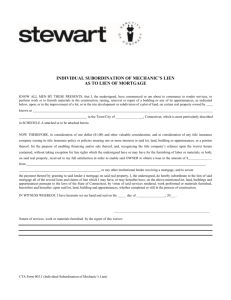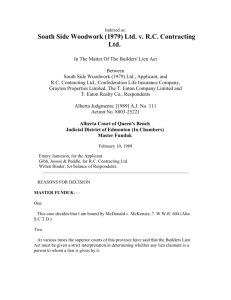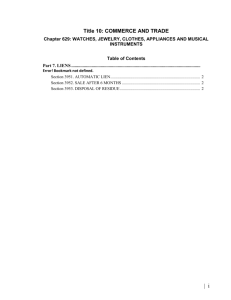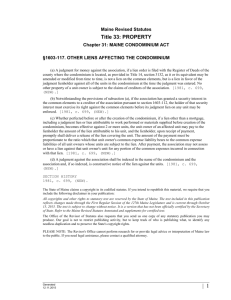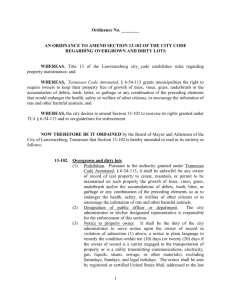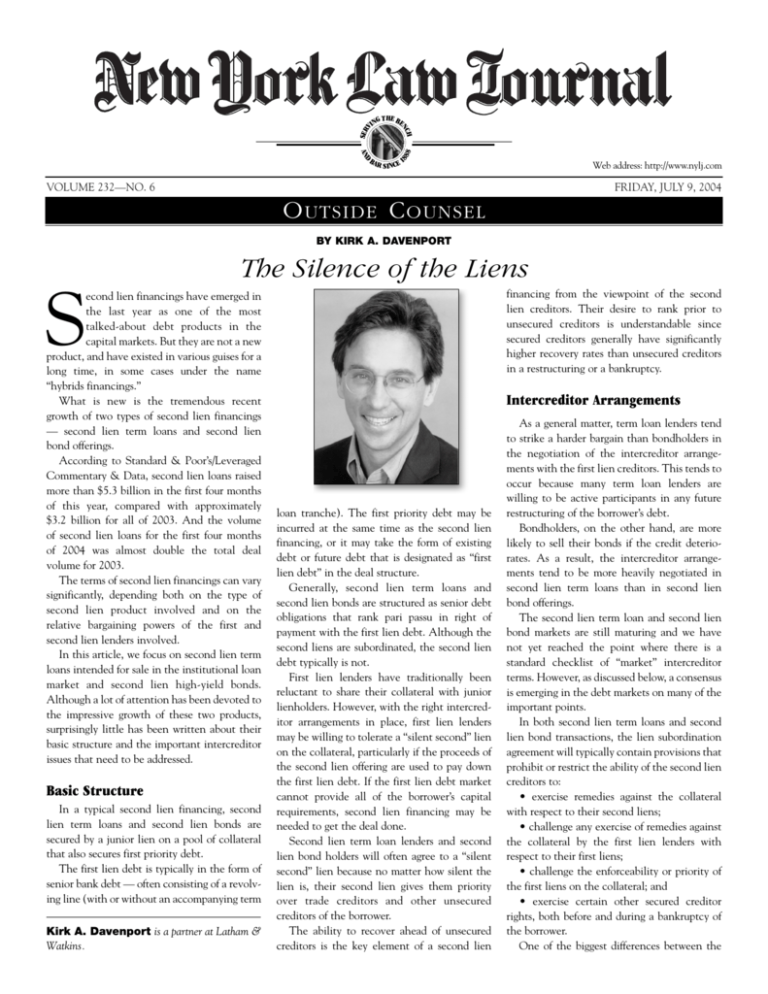
AND
88
8
SER
V
H
NC
THE BE
ING
BA
R SINCE 1
Web address: http://www.nylj.com
VOLUME 232—NO. 6
FRIDAY, JULY 9, 2004
O UTSIDE C OUNSEL
BY KIRK A. DAVENPORT
The Silence of the Liens
financing from the viewpoint of the second
lien creditors. Their desire to rank prior to
unsecured creditors is understandable since
secured creditors generally have significantly
higher recovery rates than unsecured creditors
in a restructuring or a bankruptcy.
S
econd lien financings have emerged in
the last year as one of the most
talked-about debt products in the
capital markets. But they are not a new
product, and have existed in various guises for a
long time, in some cases under the name
“hybrids financings.”
What is new is the tremendous recent
growth of two types of second lien financings
— second lien term loans and second lien
bond offerings.
According to Standard & Poor’s/Leveraged
Commentary & Data, second lien loans raised
more than $5.3 billion in the first four months
of this year, compared with approximately
$3.2 billion for all of 2003. And the volume
of second lien loans for the first four months
of 2004 was almost double the total deal
volume for 2003.
The terms of second lien financings can vary
significantly, depending both on the type of
second lien product involved and on the
relative bargaining powers of the first and
second lien lenders involved.
In this article, we focus on second lien term
loans intended for sale in the institutional loan
market and second lien high-yield bonds.
Although a lot of attention has been devoted to
the impressive growth of these two products,
surprisingly little has been written about their
basic structure and the important intercreditor
issues that need to be addressed.
Basic Structure
In a typical second lien financing, second
lien term loans and second lien bonds are
secured by a junior lien on a pool of collateral
that also secures first priority debt.
The first lien debt is typically in the form of
senior bank debt — often consisting of a revolving line (with or without an accompanying term
Kirk A. Davenport is a partner at Latham &
Watkins.
Intercreditor Arrangements
loan tranche). The first priority debt may be
incurred at the same time as the second lien
financing, or it may take the form of existing
debt or future debt that is designated as “first
lien debt” in the deal structure.
Generally, second lien term loans and
second lien bonds are structured as senior debt
obligations that rank pari passu in right of
payment with the first lien debt. Although the
second liens are subordinated, the second lien
debt typically is not.
First lien lenders have traditionally been
reluctant to share their collateral with junior
lienholders. However, with the right intercreditor arrangements in place, first lien lenders
may be willing to tolerate a “silent second” lien
on the collateral, particularly if the proceeds of
the second lien offering are used to pay down
the first lien debt. If the first lien debt market
cannot provide all of the borrower’s capital
requirements, second lien financing may be
needed to get the deal done.
Second lien term loan lenders and second
lien bond holders will often agree to a “silent
second” lien because no matter how silent the
lien is, their second lien gives them priority
over trade creditors and other unsecured
creditors of the borrower.
The ability to recover ahead of unsecured
creditors is the key element of a second lien
As a general matter, term loan lenders tend
to strike a harder bargain than bondholders in
the negotiation of the intercreditor arrangements with the first lien creditors. This tends to
occur because many term loan lenders are
willing to be active participants in any future
restructuring of the borrower’s debt.
Bondholders, on the other hand, are more
likely to sell their bonds if the credit deteriorates. As a result, the intercreditor arrangements tend to be more heavily negotiated in
second lien term loans than in second lien
bond offerings.
The second lien term loan and second lien
bond markets are still maturing and we have
not yet reached the point where there is a
standard checklist of “market” intercreditor
terms. However, as discussed below, a consensus
is emerging in the debt markets on many of the
important points.
In both second lien term loans and second
lien bond transactions, the lien subordination
agreement will typically contain provisions that
prohibit or restrict the ability of the second lien
creditors to:
• exercise remedies against the collateral
with respect to their second liens;
• challenge any exercise of remedies against
the collateral by the first lien lenders with
respect to their first liens;
• challenge the enforceability or priority of
the first liens on the collateral; and
• exercise certain other secured creditor
rights, both before and during a bankruptcy of
the borrower.
One of the biggest differences between the
NEW YORK LAW JOURNAL
intercreditor package typically agreed to by
term loan lenders and the intercreditor terms
often accepted by bondholders relates to the
exercise of remedies by the second lien creditors
against their collateral.
Second lien bondholders will generally agree
not to take any enforcement actions against
their collateral until the first lien creditors have
been repaid in full. Second lien term loan
lenders, on the other hand, will usually agree
only to a brief standstill period of 90 to 180 days
in which the first lien lenders have the sole
right to control enforcement actions. Once
that period lapses, the first lien lenders lose
their enforcement monopoly.
Second lien term loan lenders and second
lien bondholders often take the same approach
on a number of intercreditor issues. Both
groups will generally agree not to challenge the
first liens or any foreclosure action or other
exercise of remedies by the first lien lenders
against the collateral.
In addition, during a bankruptcy, both term
loan lenders and bondholders will typically give
advance consents to:
• any use of cash collateral approved by the
first lien creditors;
• sales of collateral approved by the first lien
lenders and the bankruptcy court, so long as the
second liens continue to attach to the sale
proceeds; and
• debtor-in-possession, or DIP, financings
(although often the consent will be conditioned either on a dollar cap on the amount of
the DIP financing or on a requirement that
the liens on the collateral securing the DIP
financing rank prior to or equal with the first
liens in order to avoid the DIP liens being
sandwiched between the first liens and the
second liens).
However, second lien term lenders and
second lien bondholders often take a different
approach when it comes to waivers of
“adequate protection” rights. The right to ask
the bankruptcy court for “adequate protection”
against declines in the value of that creditor’s
interest in the collateral is an important protection for a secured creditor in a bankruptcy.
Since second lien term loan lenders are
more likely than second lien bondholders to
take an active role in any reorganization of the
borrower, many institutional term loan lenders
strongly oppose any waiver of adequate
protection rights. However, some term loan
lenders will agree to this waiver and the term
loan market is not settled on the point. The
market seems more settled in high yield bond
offerings and bondholders will often agree to
FRIDAY, JULY 9, 2004
waive their “adequate protection” rights, as
long as they reserve the right to ask the
bankruptcy court for a junior lien on any
property on which the court grants a lien to
secure the first lien debt.
In some deals, first lien lenders have asked
second lien term lenders and second lien
bondholders to agree to restrictions or
limitations on their ability to vote their claims
in a plan of reorganization. First and second
lien creditors have very different interests at
stake in a bankruptcy, and second lien term
lenders and second lien bondholders have
------------------------------------------------
Second lien term loan
lenders and second lien bond
holders will often agree to a
“silent second” lien because
no matter how silent the lien
is, their second lien gives them
priority over trade creditors
and other unsecured creditors
of the borrower.
------------------------------------------------
generally pushed back strongly on this issue. It
is not clear where the market will settle on
this issue, in part because of lingering
doubts over the enforceability of these types of
voting restrictions.
Deal Documentation
The intercreditor arrangements discussed
above are usually documented in an intercreditor agreement or a collateral trust agreement.
Collateral trust agreements have generally
been favored in second lien bond transactions.
In second lien term loans, intercreditor
agreements are usually used. Substantively,
however, it does not matter which type of
agreement is used.
Another documentation issue that often
comes up in these deals is whether the first and
second liens can be created in a single set of
collateral documents. Second lien term lenders
and second lien bondholders tend to be
indifferent on this question. However, because
of a 1991 bankruptcy court ruling in the case of
In re Ionosphere Clubs, Inc. (134 B.R. 528
(Bankr. S.D. N.V. 1991), first lien lenders are
often concerned that using a single set of
collateral documents may jeopardize their right
to post-petition interest.
In that case, three series (series A, B and C)
of creditors had a security interest in the same
assets of a bankrupt company. The security
interest for each of the series A, B and C
creditors was granted in the same security
agreement. The security agreement contained a
single “granting clause” that granted one
security interest in favor of the series A, B and
C creditors.
Under the Bankruptcy Code, only an
oversecured creditor is entitled to post-petition
interest. A creditor is oversecured if the value of
its interest in its collateral exceeds the amount
of its claim. If the series A, B and C creditors
each held a separate secured claim, the series A
creditors would be oversecured and the series B
and C creditors would be undersecured.
However, if the series A, B and C creditors were
co-owners of a single combined secured claim,
the entire class, including the class A creditors,
would be undersecured.
The bankruptcy court held that the series A,
B and C creditors were co-owners of a single
secured claim because the series A, B and C
creditors were secured by a single security
interest. The court stated that, if the three
series had been secured by three separate liens
on the collateral, there would have been three
separate secured claims.
If properly drafted, a single set of collateral
documents should work to ensure that the first
and second lien creditors hold separate secured
claims. In order to steer a path around the
Ionosphere decision, each security document
should contain two separate granting clauses
creating the first and second liens, respectively,
and include a clear statement of the secured
creditors’ intent to create two separate classes of
secured creditors.
Conclusions
Second lien term loans and second
lien bonds are increasingly popular tools to
raise capital in the debt markets that are here to
stay. As more deals are done, expect to
see greater consensus between first and second
lien creditors on the intercreditor terms, in
much the same way that market standards
evolved over time on the terms of contractual
debt subordination in subordinated high
yield transactions.
This article is reprinted with permission from
the July 9, 2004 edition of the NEW YORK
LAW JOURNAL. © 2004 ALM Properties, Inc.
All rights reserved. Further duplication without
permission is prohibited. For information, contact
American Lawyer Media, Reprint Department at
800-888-8300 x6111. #070-07-04-0032

